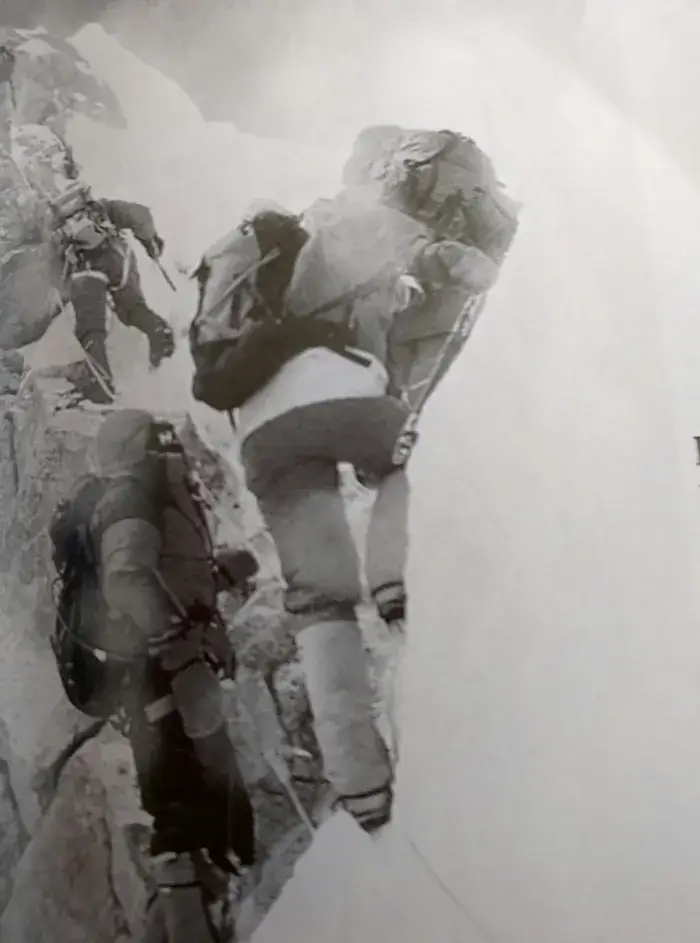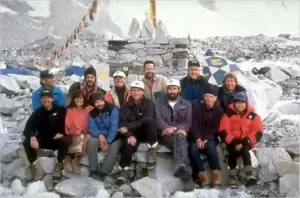Doug Hansen was an American climber and postal worker who died during the infamous 1996 Mount Everest disaster. Known as the “mailman” due to his profession, Hansen was part of Rob Hall’s Adventure Consultants team, which aimed to summit Everest during the 1996 climbing season. Unfortunately, the expedition turned disastrous due to a combination of factors such as poor decision-making, a fierce blizzard, and unexpected delays.
In 2015, Universal Studios distributed a commercially successful film ‘Everest’ starring Jason Clarke, John Hawkes, Keira Knightley, Jake Gyllenhaal, Michael Kelly, and others.

It went on to gross $203 million worldwide. Real events inspired the film. In the movie, John Hawkes played Doug Hansen, the mailman who conquered Everest.
Who was Doug Hansen?
Born in 1949 in Seattle, Washington, Doug Hansen grew up in poverty. Hansen had two jobs to meet his daily needs. He worked as a postal worker and as a driver. Growing up in poverty didn’t stop him from dreaming of conquering Mount Everest, the highest mountain on Earth.
Mount Rainier, which looms 59 miles southwest of Seattle, could have possibly inspired Hansen. As he grew up, he was more than determined to scale Everest. Doug Hansen, the ‘mailman’ who conquered the highest peak in the world, Mount Everest, is an ordinary man with an extraordinary feat.
Hansen’s story is one of determination, perseverance, and the triumph of the human spirit. Hansen attempted to summit Mount Everest in 1995 as a part of an expedition by Adventure Consultants led by Rob Hall, an accomplished New Zealand climber. He had to return back, just 300 meters short of the summit, due to bad weather.
Hansen couldn’t think of a second attempt as the fee to ascent Everest under Rob’s supervision was $65,000 per person. But, as Hall was fond of Doug, he offered a significant discount in fees to climb again in 1996. Doug was also inspired by schoolchildren in Kent, who had given him a small flag to plant at the top of Everest. He had also mortgaged his home to finance the climb.
1996 Adventure Consultants Expedition
The 1996 Adventure Consultants expedition was a commercial climbing expedition to Mount Everest led by Rob Hall. The expedition team consisted of several clients and experienced Sherpa climbers, including the mailman, Doug Hansen.
Before the expedition, Doug Hansen and his teammate spent several weeks acclimatizing and establishing camps at various points on the mountain. Hansen reached the summit of Mount Everest on the 10th of May 1996 with other members of Rob’s team. However, the team was caught in a severe storm with high winds and sub-zero temperatures on their descent.

The harsh conditions of the mountains made the rescue even more complicated. Eight climbers died on the mountain during the storm, including Hall and Hansen.
The 1996 expedition primarily involved a rivalry between Rob Hall’s Adventure Consultants and Scott Fischer’s Mountain Madness. Scott Fischer, a highly skilled American guide, joined forces with Hall to lead their respective clients to the summit of Everest. Fischer successfully reached the peak with his clients during this ascent.
Rob Hall established a 2 pm deadline for his clients to reach the summit in order to avoid the extreme weather conditions and poor visibility common on Everest. However, congestion at the base of the Hillary Step and the expedition Sherpas’ inability to fix ropes in a timely manner caused delays. By 2 pm, only a few climbers had reached the summit. Recognizing that his competitor, Scott Fischer, had successfully ascended with his clients, Hall decided to extend the deadline. Around 4 pm, Hall and his clients finally conquered Mount Everest.
The expedition has faced extensive scrutiny and analysis, raising questions about the commercialization of Everest climbing and its associated risks. Jon Krakauer‘s book “Into Thin Air” recounts the disastrous event, which is regarded as one of the deadliest climbing accidents in Mount Everest’s history.
As one ascends, oxygen levels decrease, leading to constant fatigue and frequent hyperventilation at high altitudes. Mount Everest has one-third less oxygen compared to sea level. Even smaller, trekkable mountains in Nepal necessitate acclimatization. It is hazardous to continue climbing higher altitudes without proper acclimatization. To summit Mount Everest, a month-long acclimatization process is required.
During acclimatization, Doug experienced respiratory difficulties. Two weeks before the final ascent on April 26th, Jon Krakauer, a fellow climber in the expedition, had to wake Doug from his sleeping bag after Doug expressed concerns about his throat and doubts about his ability to climb due to his age.
That same day, Doug discovered frostbite forming on the toes he had previously lost during his 1995 climb. Before the final ascent, Doug informed Hall that he might not be able to climb Everest, as he felt uncomfortable and struggled to speak. Hall encouraged Doug to persevere. Despite his concerns, Doug was reluctant to abandon the climb, as he had invested significant effort, money, and time into the endeavour and ultimately decided to continue.
On the final day, Doug Hansen was not feeling well. He informed his team members that he hadn’t eaten or slept properly for several days and expressed a desire to descend. However, after a brief conversation with Hall, Doug decided to continue the ascent.
What happened to Doug Hansen?
After a short stay at the top of Everest, Hansen headed back with Rob. They ran out of supplemental oxygen. Soon, Doug became physically and mentally weak. Before leaving for Nepal, Doug had also undergone a minor throat surgery and was feeling severe aftereffects. Hall had then advised him to wait for a couple of days before beginning the summit.
Rob attempted to encourage Doug to keep moving, but Doug was already struggling with exhaustion and hypothermia. Rob was unable to leave his client alone or help him descend the steep Hillary Step. By 6 pm, Hall descended alone to an area known as the South Summit.
Andy Harris, a member of Hall’s team, found Hansen and tried to provide him with oxygen, but Hansen was too weak to continue. Eventually, Harris had to leave Hansen in order to save his own life. At this point, Doug Hansen and Andy Harris had lost contact with Rob. Stranded, Hall radioed for help but ultimately succumbed to the mountain along with other climbers. Hansen’s body remained on the mountain for several years before another expedition discovered it in 2005.
How Did Hansen die?
The exact events surrounding Doug’s fate that evening remain unknown. It is speculated that he lost his footing and fell 7,000 feet to his death. His ice axe was later discovered lodged in the ridge. Struggling to move due to the lack of oxygen, Hansen ultimately succumbed to hypothermia.

